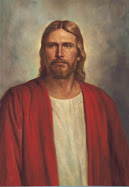Hymn #328 - the men's choir arrangement of the hymn
(Oh, the harmonies of this one--and all men singing it! *sigh* I don't know music well enough to sight read if what is sung here is what the men's choir arrangement in the hymn is. But it is beautiful!)
This song either came to my attention because it was difficult for me to play (at first) or because as a conductor it switches time signatures in the middle! I have managed this one in my organ lessons--it is hard to make all of those moving notes legato! This one also stands out because it has 2 more verses after the music stanzas, which of course means they rarely get sung. Unless you are in my ward! ha ha ha ha ha ha ha. No, that is not an (extremely) evil laugh. It is just the power of choice I exercise in allowing all of the lyricist's words and message to be sung instead of only half of it. Otherwise it is like saying, "Once upon a time Little Red Riding Hood met a wolf. He came up with a plan. He went to Granny's house and ate her. The end." You're missing vital parts of the message if you don't sing every verse! Now I understand this is sometimes done to save time in meetings. And other verses got completely left out of the hymnals (wait till we get to Hymn #124!) for whatever reasons. But I appreciate poems, and stories, and love music. And I am of the belief, even if my arms will get tired as the chorister, that all verses should be sung if they took the trouble to put them all in there. (Though guess who hasn't picked a 7+ verse song for Sacrament meeting, yet?)
Anyway! Back to the hymn and away from my diatribe. This is a Restoration song, though the first 3 verses are specifically about the Book of Mormon. How apropos! My Conference talk today was Elder Stevenson's recent one about the Book of Mormon. The last two verses (the "unsung one") are more a prediction or statement about how the Book of Mormon and Restoration will fill the world with light and truth and there will be much rejoicing. I see that happening every day still, 180+ years later. There may be a lot of awfulness in this world, but when you step back and look at all those who are hearing, accepting, and receiving the Gospel and its ordinances, covenants, and blessings--there is so much to rejoice about!
From the history book
The hymn was not included in the first, 1835 LDS hymnal. But it was in 1840 (when Parley P. Pratt was one of the editors....). The tune we sing it to was first printed in 1857, and helps convey the first two lines of each verse, then markedly showing the difference in the last lines. "The first half of each stanza of the text is narrative and explanatory, whereas the last half is a declaration and a testimony." This current hymnal added some harmonizations that would be easier for congregations to sing and not just choirs. However, most wards I have been in rarely sing this one.




No comments:
Post a Comment